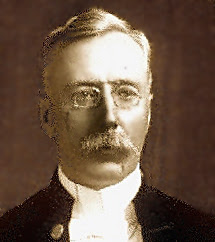 |
| Statue of Marquess Dufferin - Calcutta |
Lord Dufferin (1884-88) served as Governor General of India and Viceroy from 1884 to 1888. Educated at Eton and Christ Church, Oxford he had held many important political and diplomatic posts which include British Commissioner in Syria, 1860; Under Secretary of State for India, 1864-66; Under Secretary for War, 1866; Governor General of Canada, 1872-78; ambassador in St. Petersburg, 1879 and ambassador to Turkey, 1881. During his tenure, the Third Burmese war led to annexation of whole of Burma and Burmese ruler was exiled to India. In 1885, A.O. Hume laid the foundation of Indian National Congress (INC). In 1885, an important political event took place in Afghanistan called the Panjdeh Incident. The Russian forces seized Afghan territory south of Amu Darya around site of Panjdeh {now located in Turkmenistan}. This created a unpalatable diplomatic crisis between Russia and Great Britain.
1. Foundation of Indian National Congress (INC) in Bombay (28th December 1885): Allan Octavian Hume in May 1885, upon getting approval from Viceroy Dufferin created an “Indian National Union”. It had affiliation with the government and served as a platform to voice Indian public opinion. The Indian National Congress was founded on 28 December 1885 at Gokuldas Tejpal Sanskrit College in Bombay, with 72 delegates in attendance. The first session presided by Womesh Chandra Bonnerjee, adopted a resolution expressing the dissatisfaction on the current system of Governance and demanded reforms in the Councils. Responding to it, Lord Dufferin had established a committee for the reforms in the councils and this resulted in the Indian Councils Act 1892. This act introduced the principle of representation in India.
2. Third Anglo-Burmese war: During his tenure, the Third Burmese war led to annexation of whole of Burma and Burmese ruler was exiled to India.
In 1886 upper Burma was annexed. The lower Burma was annexed by Lord Dalhousie but upper Burma was still independent and the ruler King Thebau had close alliance with the French. The increasing French influence and lack of cooperation of the Burmese ruler with the British, particularly with reference to the Bombay Burma Trading Company's access to China through Burmese territory irked the British. The ruler of Upper Burma rejected Lord Dufferin's warning. British invaded upper Burma and within two weeks King surrendered. He was taken prisoner and was sent to Madras. On January 1, 1886, the territories of Burma were annexed to British India and on September 25, 1886, Lower Burma was annexed as province of British India under Sir Charles Bernard as the first chief commissioner. This aggressive action by the British became a subject of severe criticism. Many writers called it “unjust” and a result of imperialism. Thebaw was an independent ruler and was free to establish diplomatic relations with any country. There was widespread protest in "Burma. Indian leaders preferred to make Burma a Crown Colony" like Ceylon rather than a province of India.
4. Hutchinson Committee was appointed to review the Civil Services. It suggested the abolition of the Statutory Civil Services and strengthening of provincial services. But it rejected the demand for simultaneous exams in India to the ICS.
5. Lord Dufferin threw a garden tea party for the Congress leaders in 1886, when the INC held its second session in Calcutta. But later, he was upset with the policies of the Party and commented that it was a “microscopic minority jumped into the un-known” and called it “Annual Babu Congress”.
Lord Dufferin, successor to very popular Lord Rippon, had good relationship with the natives and earned their goodwill, but his fellow men considered him a renegade. His important contributions are his honest report on the poor condition of the lower class people in Bengal (1888), consisting mostly of farmers and workers.
The finding of the report prepared under Dufferin strengthened the Congress theory that country would never prosper without participation of the natives in the governance of the country. Dufferin, being a man with commonsense and scholarly bend of mind himself got convinced of the argument. He openly supported the Congress demand for establishing provincial and central councils with elected members and suggested some measures to meet Indian nationalist demands for the Home Rule. The Indian Councils Act of 1892, which inaugurated the electoral politics in the country, was the outcome of his recommendations. Lord Dufferin died on 12 February 1902.
Tit-Bits - Dufferin Clock Tower, Mysore:
 |
| Dufferin Clock Tower 1886, Mysore city. en.wikipedia.o |
Above image: The Dufferin Clock Tower of Mysore is a popular landmark and is located in front of the Deveraja Market near the new bus station in Mysore city. During his tenure as Viceroy Dufferin visited Mysore at the the invitation of the Maharajah of Mysore Chamaraja Wodeyar. His visit happened to be an important one because Lord Dufferin was the first Viceroy of the colonial India to pay a ceremonial and friendly visit to Mysore. Befitting the honorable British Chief visiting Mysore for the first time, a majestic, but simple cloak tower was built in 1886 in his memory which the local people call Chikka Gadiyara or the small clock tower. Set in the prime area of the city, it was built on a strong foundation consisting of eight pillars covered by railings.
In 2012, the city council completed the work of renovating adequate space around the clock tower by fixing tiles and seats for tourists. It is now a heritage structure in Mysore and served as time keeper during the reign of the Wadeyars.
In 2012, the city council completed the work of renovating adequate space around the clock tower by fixing tiles and seats for tourists. It is now a heritage structure in Mysore and served as time keeper during the reign of the Wadeyars.
\











 ,
,





















































